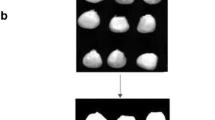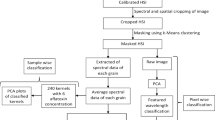Abstract
Contamination of aflatoxins has important effect on the quality of corn seed. In this study, hyperspectral imaging technology was used to detect aflatoxin B1 (AFB1) with different concentrations (100, 50, 30, 20 and 10 μg/kg) on corn seeds. The near-infrared hyperspectral data, which were collected from the corn seed samples, were processed by image segmentation method. Then, the spectra in the range of 460–929 nm in the region of seed embryo were extracted from the seed-embryo hyperspectral image. Next, the modeling performance of two schemes under four preprocessing methods (none, multiplicative scatter correction (MSC), standard normal variate (SNV), and 5–3 smoothing), four feature wavelength extraction methods (full wavelength, principal component analysis (PCA), X-loading, and successive projection algorithm (SPA)) and three chemometrics methods (k-nearest neighbor (KNN), linear discriminant analysis (LDA), and support vector machine (SVM)) were compared. The optimal result of the testing set is in the case of “5–3 smoothing” pretreatment, SPA method, and SVM model, with 84.1%, 77.8% and 87.3%, 83.0% accuracies of the training set and testing set respectively in scheme 1 and scheme 2. The optimal accuracy of the testing set obtained by “SPA method” is 3.5% higher than in the case of “full wavelength” method, reducing the model calculations and improving the model accuracy to a certain extent. These 10 wavelengths (460.41, 491.50, 594.72, 617.60, 679.77, 726.69, 739.00, 772.43, 926.10, and 929.03 nm) obtained by “SPA method” provide the possibility for real-time online monitoring AFB1 contamination on corn seeds in the future.




Similar content being viewed by others
References
M. Abrar, F.M. Anjum, M.S. Butt, I. Pasha, M.A. Randhawa, F. Saeed, K. Waqas, Aflatoxins: biosynthesis, occurrence, toxicity, and remedies. Crit. Rev. Food Sci. Nutr. 53(8), 862–874 (2013). https://doi.org/10.1080/10408398.2011.563154
Q. Wu, L. Xie, H. Xu, Determination of toxigenic fungi and aflatoxins in nuts and dried fruits using imaging and spectroscopic techniques. Food Chem. 252, 228–242 (2018). https://doi.org/10.1016/j.foodchem.2018.01.076
X. He, C. Yan, X. Jiang, F. Shen, J. You, Y. Fang, Classification of aflatoxin B1 naturally contaminated peanut using visible and near-infrared hyperspectral imaging by integrating spectral and texture features. Infrared Phys. Technol. 114, 103652 (2021). https://doi.org/10.1016/j.infrared.2021.103652
H.K. Abbas, R.D. Cartwright, W. Xie, W. Thomas Shier, Aflatoxin and fumonisin contamination of corn (maize, Zea mays) hybrids in Arkansas. Crop Prot. 25(1), 1–9 (2006). https://doi.org/10.1016/j.cropro.2005.02.009
S.M. Herzallah, Determination of aflatoxins in eggs, milk, meat and meat products using HPLC fluorescent and UV detectors. Food Chem. 114(3), 1141–1146 (2009). https://doi.org/10.1016/j.foodchem.2008.10.077
A. Waśkiewicz, M. Beszterda, P. Goliński, Occurrence of fumonisins in food—an interdisciplinary approach to the problem. Food Control 26(2), 491–499 (2012). https://doi.org/10.1016/j.foodcont.2012.02.007
L. Xie, M. Chen, Y. Ying, Development of methods for determination of aflatoxins. Crit. Rev. Food Sci. Nutr. 56(16), 2642–2664 (2016)
D. Kimuli, W. Wang, K.C. Lawrence, S. Yoon, X. Ni, G.W. Heitschmidt, Utilisation of visible/near-infrared hyperspectral images to classify aflatoxin B1 contaminated maize kernels. Biosys. Eng. 166, 150–160 (2018). https://doi.org/10.1016/j.biosystemseng.2017.11.018
D. Kimuli, W. Wang, W. Wang, H. Jiang, X. Zhao, X. Chu, Application of SWIR hyperspectral imaging and chemometrics for identification of aflatoxin B1 contaminated maize kernels. Infrared Phys. Technol. 89, 351–362 (2018). https://doi.org/10.1016/j.infrared.2018.01.026
I. Orina, M. Manley, P.J. Williams, Non-destructive techniques for the detection of fungal infection in cereal grains. Food Res. Int. 100, 74–86 (2017). https://doi.org/10.1016/j.foodres.2017.07.069
T. Falade, Y. Sultanbawa, M. Fletcher, G. Fox, Near infrared spectrometry for rapid non-invasive modelling of Aspergillus-contaminated maturing kernels of Maize (Zea mays L.). Agriculture 7(9), 77 (2017). https://doi.org/10.3390/agriculture7090077
V. Fernández-Ibañez, A. Soldado, A. Martínez-Fernández, B. de la Roza-Delgado, Application of near infrared spectroscopy for rapid detection of aflatoxin B1 in maize and barley as analytical quality assessment. Food Chem. 113(2), 629–634 (2009). https://doi.org/10.1016/j.foodchem.2008.07.049
T.C. Pearson, D.T. Wicklow, E.B. Maghirang, F. Xie, F.E. Dowell, Detecting aflatoxin in single corn kernels by transmittance and reflectance spectroscopy. Trans. ASAE 44(5), 1247–1254 (2001). https://doi.org/10.13031/2013.6418
T.C. Pearson, D.T. Wicklow, M.C. Pasikatan, Reduction of aflatoxin and fumonisin contamination in yellow corn by high speed dual wavelength sorting. Cereal Chem. 81(4), 490–498 (2004). https://doi.org/10.1094/CCHEM.2004.81.4.490
X. Chu, W. Wang, S. Yoon, X. Ni, G.W. Heitschmidt, Detection of aflatoxin B1 (AFB1) in individual maize kernels using short wave infrared (SWIR) hyperspectral imaging. Biosys. Eng. 157, 13–23 (2017). https://doi.org/10.1016/j.biosystemseng.2017.02.005
L. Wang, D. Sun, H. Pu, Z. Zhu, Application of hyperspectral imaging to discriminate the variety of maize seeds. Food Anal. Methods 9(1), 225–234 (2016). https://doi.org/10.1007/s12161-015-0160-4
X. Yang, H. Hong, Z. You, F. Cheng, Spectral and image integrated analysis of hyperspectral data for waxy corn seed variety classification. Sensors 15(7), 15578–15594 (2015). https://doi.org/10.3390/s150715578
J. Zhang, L. Dai, F. Cheng, Corn seed variety classification based on hyperspectral reflectance imaging and deep convolutional neural network. J. Food Meas. Charact. 15(1), 484–494 (2021). https://doi.org/10.1007/s11694-020-00646-3
J. Zhang, L. Dai, F. Cheng, Identification of corn seeds with different freezing damage degree based on hyperspectral reflectance imaging and deep learning method. Food Anal. Methods 14(2), 389–400 (2021). https://doi.org/10.1007/s12161-020-01871-8
Z. Wang, X. Tian, S. Fan, C. Zhang, J. Li, Maturity determination of single maize seed by using near-infrared hyperspectral imaging coupled with comparative analysis of multiple classification models. Infrared Phys. Technol. 112, 103596 (2021). https://doi.org/10.1016/j.infrared.2020.103596
J. Zhang, L. Dai, F. Cheng, Classification of frozen corn seeds using hyperspectral VIS/NIR reflectance imaging. Molecules 24(1), 149 (2019). https://doi.org/10.3390/molecules24010149
C. McGoverin, M. Manley, Classification of maize kernel hardness using near infrared hyperspectral imaging. J. Near Infrared Spectrosc. 20(5), 529 (2012). https://doi.org/10.1255/jnirs.1018
F. Zhu, H. Yao, Z. Hruska, R. Kincaid, R. Brown, D. Bhatnagar, T. Cleveland, Integration of fluorescence and reflectance visible near-infrared (VNIR) hyperspectral images for detection of aflatoxins in corn kernels. Trans. Asabe 59(3), 785–794 (2016)
A. Candolfi, R. De Maesschalck, D. Jouan-Rimbaud, P.A. Hailey, D.L. Massart, The influence of data pre-processing in the pattern recognition of excipients near-infrared spectra. J. Pharm. Biomed. Anal. 21(1), 115–132 (1999). https://doi.org/10.1016/s0731-7085(99)00125-9
H. Chen, Q. Song, G. Tang, Q. Feng, L. Lin, The combined optimization of Savitzky-Golay smoothing and multiplicative scatter correction for FT-NIR PLS models. ISRN Spectrosc. 2013, 1–9 (2013). https://doi.org/10.1155/2013/642190
S. Wold, K. Esbensen, P. Geladi, Principal component analysis. Chemom. Intell. Lab. Syst. 2(1–3), 37–52 (1987). https://doi.org/10.1016/0169-7439(87)80084-9
D. Liu, D. Sun, X. Zeng, Recent advances in wavelength selection techniques for hyperspectral image processing in the food industry. Food Bioprocess Technol. 7(2), 307–323 (2014). https://doi.org/10.1007/s11947-013-1193-6
J. Riba Ruiz, T. Canals, R. Cantero Gomez, Comparative study of multivariate methods to identify paper finishes using infrared spectroscopy. IEEE Trans. Instrum. Meas. 61(4), 1029–1036 (2012). https://doi.org/10.1109/TIM.2011.2173048
N. Mohanty, L.S. John, R. Manmatha, T.M. Rath, Shape-based image classification and retrieval. Handb. Stat. 31, 249–267 (2013). https://doi.org/10.1016/B978-0-444-53859-8.00010-2
C.J.C. Burges, A tutorial on support vector machines for pattern recognition. Data Min. Knowl. Disc. 2(2), 121–167 (1998). https://doi.org/10.1023/A:1009715923555
M.E. Mavroforakis, S. Theodoridis, A geometric approach to Support Vector Machine (SVM) classification. IEEE Trans. Neural Netw. 17(3), 671–682 (2006). https://doi.org/10.1109/TNN.2006.873281
L. Smeesters, W. Meulebroeck, S. Raeymaekers, H. Thienpont, Optical detection of aflatoxins in maize using one- and two-photon induced fluorescence spectroscopy. Food Control 51, 408–416 (2015). https://doi.org/10.1016/j.foodcont.2014.12.003
J. Jiang, X. Qiao, R. He, Use of near-infrared hyperspectral images to identify moldy peanuts. J. Food Eng. 169, 284–290 (2016). https://doi.org/10.1016/j.jfoodeng.2015.09.013
J. Zhang, F. Cheng, Application of hyperspectral reflectance imaging and chemometric methods to classify the corn seed variety. ASABE 2020 Annual International Meeting (2020). https://doi.org/10.13031/aim.202000327
Funding
This research was funded by the National Natural Science Foundation of China (Grant No. 61873231).
Author information
Authors and Affiliations
Corresponding author
Ethics declarations
Conflict of interest
Jun Zhang declares that he has no conflict of interest. Binbo Xu declares that he has no conflict of interest. Zhiying Wang declares that she has no conflict of interest. Fang Cheng declares that she has no conflict of interest.
Ethical approval
This article does not contain any studies with human or animal subjects.
Informed consent
Informed consent was obtained from all individual participants included in this study.
Additional information
Publisher's Note
Springer Nature remains neutral with regard to jurisdictional claims in published maps and institutional affiliations.
Rights and permissions
About this article
Cite this article
Zhang, J., Xu, B., Wang, Z. et al. Application of hyperspectral imaging in the detection of aflatoxin B1 on corn seed. Food Measure 16, 448–460 (2022). https://doi.org/10.1007/s11694-021-01171-7
Received:
Accepted:
Published:
Issue Date:
DOI: https://doi.org/10.1007/s11694-021-01171-7




